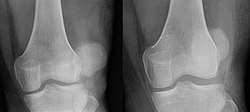Patella luxation
From WikiLectures
Under construction / Forgotten
|
This article was marked by its author as Under construction, but the last edit is older than 30 days. If you want to edit this page, please try to contact its author first (you fill find him in the history). Watch the discussion as well. If the author will not continue in work, remove the template Last update: Thursday, 30 Mar 2023 at 6.49 pm. |
This article has been translated from WikiSkripta; ready for the editor's review.
Etiology[edit | edit source]
- trauma / congenital disposition (more often ♀, also repeated habitual dislocations)
- the patella usually Luxates laterally
- cause of lat. luxation is almost always a congenital disposition: Knee valgus, high position of the patella (patella alta), congenital patella dysplasia, joint hyperlaxity syndrome, etc.
Diagnostics[edit | edit source]
- acute dislocation: significant change in knee contour + blocking of movement in semiflexion, haemarthros
- recurrent dislocation: Anamnesis opposite. patella luxation, congenital. disposition, sy joint hyperlaxity, clinically subluxation to luxation of the patella (examined rather in CA)
- [[X-rays imaging|X-ray] – exclusion of an associated fracture, possibly. CT
- ASK – will most accurately clarify the condition of the joint surfaces + the position of the patella
Treatment[edit | edit source]
- reduction in CA, immobilization of the knee for 4-6 weeks
- in case of recurrent dislocations, surgery – medialization of the patella open / arthroscopically (+ lateral release)
Links[edit | edit source]
Related Articles[edit | edit source]
References[edit | edit source]
- GALLO, Jiří, et al. Ortopedie pro studenty lékařských a zdravotnických fakult. 1. edition. Olomouc : Univerzita Palackého v Olomouci, 2011. ISBN 978-80-244-2486-6.

